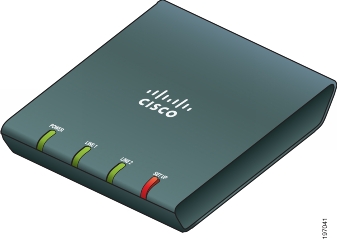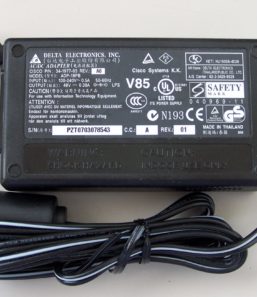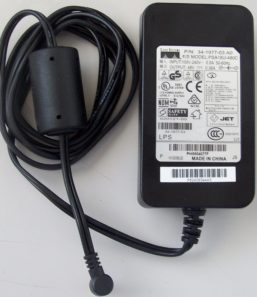Description
The Cisco ® ATA 187 Analog Telephone Adaptor is a handset-to-Ethernet adaptor that turns traditional telephone devices into IP devices.
Customers can take advantage of the many new and exciting IP telephony applications by connecting their analog devices to Cisco ATAs.
The Cisco ATA products are standards-based communication devices that deliver true, next-generation voice-over-IP (VoIP) terminations to businesses and residences worldwide.
Protects existing telephone investment: The Cisco ATA 187 supports two voice ports, each with its own independent telephone number, and a single RJ-45 10/100 BASE-T Ethernet port.
This adaptor can make use of existing Ethernet LANs in addition to broadband pipes such as DSL, fixed wireless, and cable modem deployments.
Cost effective:
The Cisco ATA 187 helps customers turn their analog phone devices into IP devices cost effectively and is the preferred solution to address the needs of customers who connect to enterprise networks, small-office environments, or the emerging VoIP managed voice services and local services market.
Enterprise customers are using the Cisco ATA 187 to connect analog phones and fax machines to their VoIP network.
Service providers are taking advantage of emerging telephony applications and the ease of deploying second-line services using the Cisco ATA 187
Cisco ATA 187 as Endpoint in Session Initiation Protocol (SIP) Network
Configuration as per Cisco endpoints devices
• Autoprovisioning with Trivial File Transfer Protocol (TFTP) for servers
• Automatic assignment of IP address, network routing IP, and subnet mask using Dynamic Host Configuration Protocol (DHCP)
• Touch-tone telephone keypad configuration with voice prompt
• Administration password to protect configuration and access
• Remote upgrades through network
• Cisco Unified Communications Manager (UCM) standard configuration and provisioning options
• Ease of administration
Voice Quality
• Advanced preprocessing to optimize full-duplex voice compression
• High-performance line-echo cancellation to eliminate noise and echo
• Voice activity detection (VAD) and comfort noise generation (CNG) to save bandwidth by delivering voice, not silence
• Dynamic network monitoring to reduce jitter artifacts such a packet loss
Clear, natural-sounding voice quality
Signaling Protocol
• Session Initiation Protocol (SIP) on the Cisco line side
Allows interoperation with Cisco UCM SIP solution
Security
• Secure Real-Time Transfer Protocol and Transport Layer Security (SRTP/TLS) over SIP
Secure media and secure signaling support, for secure solutions
Fax Support
• T38 fax support
Standard fax capability to send faxes over the IP network
Form Factor
• Fits in most environments
New form-factor design based on the Cisco endpoints portfolio
Cisco UCM Version Compatibility
• Cisco UCM Versions 7.1.5, 8.0.2, or higher
Physical Specifications
Power
Power supply: Universal AC power supply 100 and 240V
Power adaptor output voltage: +12.0 VDC at 1A maximum
Noise level
Less than 34 dBA at 3 feet
Connectors
2 RJ 11
Thermal
Operating temperature: 23 to 113°F (5 to 45 °C)
Non-operating temperature: -13 to 158ºF (-25 to 70ºC)
Humidity
Operating humidity: 5 to 95% noncondensing
Mean time between failure (MTBF)
100,000 hours
Physical dimensions
(H x W x D) and weight
Dimensions: 1.5 x 5.4 x 6.7 in. (3.8 x 13.7 x 17.0 cm)
Weight: 9.2 oz (260g)
Compliance
RoHS- and WEEE-compliant materials
On-off switch
To turn device on and off
Software Specifications
Cisco ATA SIP services
• IP address assignment: Provided by DHCP or statically configured
• Cisco ATA configuration through Cisco UCM configuration interface
• VLAN configuration
• Cisco Discovery Protocol
• Low-bit-rate codec selection
• User authentication
• Configurable tones (dial tone, busy tone, alert tone, reorder tone, and call-waiting tone)
• Dial plans
• SIP proxy server redundancy
• Privacy features
• Domain Name System (DNS) service (SRV) support
• User-configurable, call waiting; permanent default setting
• Comfort noise during silence period when using G.711
• Advanced audio mode
• Caller ID format
• Ring cadence format
• Silence suppression
• Hook-flash detection timing configuration
• Configurable on-hook delay
• Type of service (ToS) configuration for audio and signaling Ethernet packets
• Debugging and diagnostic tools
SIP services
Cisco ATA supports the methods listed here (for more information, refer to RFC-3261):
• REGISTER
• REFER
• INVITE
• BYE
• CANCEL
• NOTIFY
• OPTIONS
• ACK
• SUBSCRIBE
Supplementary services
• Caller ID
• Call-waiting caller ID
• Voice-mail indication
• Conference call
• Call waiting
• Call forwarding
• Calling-line identification
• Unattended transfer
• Attended transfer
• Shared line
• Speed dial
• Meet me
• Pick up
• Redial
Other supported protocols
• IEEE 802.1Q VLAN tagging
• Cisco Discovery Protocol
• DNS
• DHCP
• Internet Control Message Protocol (ICMP)
• IP
• Real-Time Transport Protocol (RTP)
• TCP
• Trivial File Transfer Protocol (TFTP)
• User Datagram Protocol (UDP)
Fax services
The Cisco ATA supports two modes of fax services, in which fax signals are transmitted using the G.711 codec:
• Fax pass-through mode: The mode enables receiver-side called-station-identification (CED) tone detection with automatic G.711A-law or G.711μ-law switching.
• T38 fax relay mode: The T.38 fax relay feature enables devices to use fax machines to send files over the IP network.
In general, when a fax is received, it is converted to an image, sent to the T.38 fax device, and converted back to an analog fax signal.
T.38 fax relays configured with voice gateways decode or demodulate the fax signals before they are transported over IP.
Note: Success of fax transmission depends on network conditions and the fax modem response to these conditions.
The network must have reasonably low network jitter, network delay, and packet loss rate.
Voice codecs supported
• G.711μ-law
• G.711A-law
• G.729
• G.729A
• G.729B
• G.729AB
SRTP/TLS
• SRTP secures voice conversations on the network and provides protection against replay attacks.
• TLS is a cryptographic protocol that secures data communications such as email on the Internet. TLS is functionally equivalent to SSL.
VoIP specifications
• LAN port: One RJ-45 10/100BASE-T Fast Ethernet port
• Quality of service (QoS): Precedence setting and differentiated services code point (DSCP)
Call progress tones
Configurable based on network locale
Line-echo cancellation
• Echo canceller for each port
• 8-millisecond (ms) echo length
• Nonlinear echo suppression (echo return loss [ERL] greater than 28 dB for f = 300 to 3400 Hz)







Reviews
There are no reviews yet.